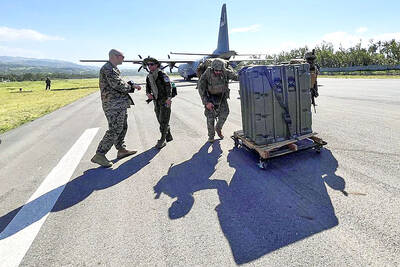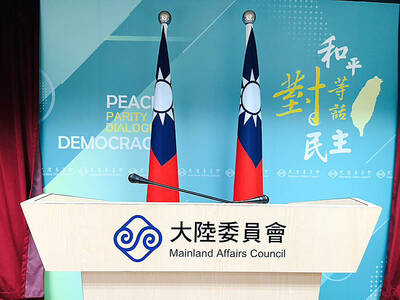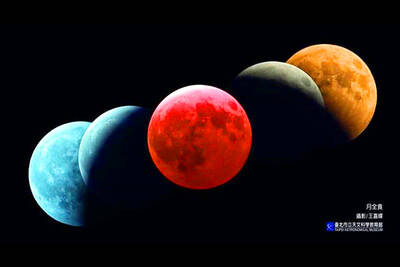The mention of the Taiwan Strait in a communique issued after a meeting of G7 leaders highlighted Taiwan’s growing strategic importance, due largely to its economic strength and location near important sea lanes, an academic said yesterday.
Lin Ying-yu (林穎佑), an assistant professor in National Chung Cheng University’s Institute of Strategic and International Affairs, said the statement reflected “Taiwan’s importance to the whole world.”
The communique was released on the last day of the meeting held from Friday to Sunday in Cornwall, England.
“We underscore the importance of peace and stability across the Taiwan Strait, and encourage the peaceful resolution of cross-strait issues,” it said. “We remain seriously concerned about the situation in the East and South China Seas, and strongly oppose any unilateral attempts to change the status quo and increase tensions.”
It was the first time the annual leaders’ meeting of the world’s seven wealthiest liberal democracies included Taiwan Strait issues in its communique since the G7’s predecessor, the G6, was formed in 1975.
Taiwan’s increasingly significant role in the region was largely due to its economic importance in semiconductor and silicon wafer supply chains, and its location near an important sea lane, Lin said.
Under the so-called “interlinkage of four seas” theory, what happens in the Taiwan Strait could also affect the South China Sea, East China Sea and Yellow Sea, he said.
Any change to the situation in the South China Sea, Taiwan, the Korean Peninsula or Japan could have an impact on the global economy, particularly in an era of economic globalization, he added.
“Amid the COVID-19 pandemic, no country would want instability in the Taiwan Strait,” he added.
Chao Chun-shan (趙春山), an honorary professor in China studies at Tamkang University, addressed the “interlinkage of four seas” theory in an article published in 2018.
He regarded the East China Sea, South China Sea, Yellow Sea and Taiwan Strait as four flashpoints in the East Asian region after the Cold War.
“The areas look independent of each other, but actually influence each other. It is like if you pull one hair, the whole body moves,” he wrote.
Institute for National Defense and Security Research analyst Shu Hsiao-huang (舒孝煌) said that China’s “wolf warrior diplomacy” and incursions into Taiwan’s air defense identification zone in the past two years have raised concerns among countries in the region.
When former US president Donald Trump was in office, the US tried to pull Europe into the Asia-Pacific region, hoping to counter China with a US-Europe alliance, Shu said.
US President Joe Biden has introduced a more refined diplomatic policy, which he has combined with economic power to achieve that goal, Shu added.
Since taking office in January, Biden has said on several occasions that the US would unite its allies to confront challenges from China, and would put human rights at the center of its diplomatic policy.
At the G7 summit, leaders of the allied countries joined Biden’s effort to some extent.
In the communique, the G7 countries pledged to promote their values by “calling on China to respect human rights and fundamental freedoms, especially in relation to Xinjiang and those rights, freedoms and high degree of autonomy for Hong Kong enshrined in the Sino-British Joint Declaration and the Basic Law.”
In a Facebook post in Chinese, President Tsai Ing-wen (蔡英文) yesterday thanked G7 member states for their “resolute support.”
Chinese Nationalist Party (KMT) Chairman Johnny Chiang (江啟臣) said that he hoped the G7 communique, aside from bringing attention to Taiwan, would also help the nation’s efforts to participate in international organizations.

Three batches of banana sauce imported from the Philippines were intercepted at the border after they were found to contain the banned industrial dye Orange G, the Food and Drug Administration (FDA) said yesterday. From today through Sept. 2 next year, all seasoning sauces from the Philippines are to be subject to the FDA’s strictest border inspection, meaning 100 percent testing for illegal dyes before entry is allowed, it said in a statement. Orange G is an industrial coloring agent that is not permitted for food use in Taiwan or internationally, said Cheng Wei-chih (鄭維智), head of the FDA’s Northern Center for

LOOKING NORTH: The base would enhance the military’s awareness of activities in the Bashi Channel, which China Coast Guard ships have been frequenting, an expert said The Philippine Navy on Thursday last week inaugurated a forward operating base in the country’s northern most province of Batanes, which at 185km from Taiwan would be strategically important in a military conflict in the Taiwan Strait. The Philippine Daily Inquirer quoted Northern Luzon Command Commander Lieutenant General Fernyl Buca as saying that the base in Mahatao would bolster the country’s northern defenses and response capabilities. The base is also a response to the “irregular presence this month of armed” of China Coast Guard vessels frequenting the Bashi Channel in the Luzon Strait just south of Taiwan, the paper reported, citing a

UNDER PRESSURE: The report cited numerous events that have happened this year to show increased coercion from China, such as military drills and legal threats The Chinese Communist Party (CCP) aims to reinforce its “one China” principle and the idea that Taiwan belongs to the People’s Republic of China by hosting celebratory events this year for the 80th anniversary of the end of World War II, the “retrocession” of Taiwan and the establishment of the UN, the Mainland Affairs Council (MAC) said in its latest report to the Legislative Yuan. Taking advantage of the significant anniversaries, Chinese officials are attempting to assert China’s sovereignty over Taiwan through interviews with international news media and cross-strait exchange events, the report said. Beijing intends to reinforce its “one China” principle

A total lunar eclipse, an astronomical event often referred to as a “blood moon,” would be visible to sky watchers in Taiwan starting just before midnight on Sunday night, the Taipei Astronomical Museum said. The phenomenon is also called “blood moon” due to the reddish-orange hue it takes on as the Earth passes directly between the sun and the moon, completely blocking direct sunlight from reaching the lunar surface. The only light is refracted by the Earth’s atmosphere, and its red wavelengths are bent toward the moon, illuminating it in a dramatic crimson light. Describing the event as the most important astronomical phenomenon